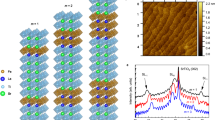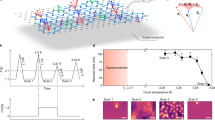Abstract
LaAlO3 and SrTiO3 are insulating, non-magnetic oxides, yet the interface between them exhibits a two-dimensional electron system with high electron mobility1, superconductivity at low temperatures2,3,4,5,6 and electric-field-tuned metal–insulator and superconductor–insulator phase transitions3,6,7,8. Bulk magnetization and magnetoresistance measurements also indicate some form of magnetism depending on preparation conditions5,9,10,11 and a tendency towards nanoscale electronic phase separation10. Here we use local imaging of the magnetization and magnetic susceptibility to directly observe a landscape of ferromagnetism, paramagnetism and superconductivity. We find submicrometre patches of ferromagnetism in a uniform background of paramagnetism, with a non-uniform, weak diamagnetic superconducting susceptibility at low temperature. These results demonstrate the existence of nanoscale phase separation as indicated by theoretical predictions based on nearly degenerate interface sub-bands associated with the Ti orbitals12,13. The magnitude and temperature dependence of the paramagnetic response indicate that the vast majority of the electrons at the interface are localized14, and do not contribute to transport measurements3,6,7. In addition to the implications for magnetism, the existence of a two-dimensional superconductor at an interface with highly broken inversion symmetry and a ferromagnetic landscape in the background indicates the potential for exotic superconducting phenomena.
This is a preview of subscription content, access via your institution
Access options
Subscribe to this journal
Receive 12 print issues and online access
$259.00 per year
only $21.58 per issue
Buy this article
- Purchase on SpringerLink
- Instant access to full article PDF
Prices may be subject to local taxes which are calculated during checkout



Similar content being viewed by others
References
Ohtomo, A. & Hwang, H. Y. A high-mobility electron gas at the LaAlO3/SrTiO3 heterointerface. Nature 427, 423–426 (2004).
Reyren, N. et al. Superconducting interfaces between insulating oxides. Science 317, 1196–1199 (2007).
Caviglia, A. D. et al. Electric field control of the LaAlO3/SrTiO3 interface ground state. Nature 456, 624–627 (2008).
Ben Shalom, M., Sachs, M., Rakhmilevitch, D., Palevski, A. & Dagan, Y. Tuning spin–orbit coupling and superconductivity at the SrTiO3/LaAlO3 interface: A magnetotransport study. Phys. Rev. Lett. 104, 126802 (2010).
Dikin, D. A. et al. Coexistence of superconductivity and ferromagnetism in two dimensions. Phys. Rev. Lett. 107, 056802 (2011).
Bell, C. et al. Dominant mobility modulation by the electric field effect at the LaAlO3/SrTiO3 interface. Phys. Rev. Lett. 103, 226802 (2009).
Thiel, S., Hammerl, G., Schmehl, A., Schneider, C. W. & Mannhart, J. Tunable quasi-two-dimensional electron gases in oxide heterostructures. Science 313, 1942–1945 (2006).
Cen, C. et al. Nanoscale control of an interfacial metal–insulator transition at room temperature. Nature Mater. 7, 298–302 (2008).
Brinkman, A. et al. Magnetic effects at the interface between non-magnetic oxides. Nature Mater. 6, 493–496 (2007).
Ariando, et al. Electronic phase separation at the LaAlO3/SrTiO3 interface. Nature Commun. 2, 188 (2011).
Seri, S. & Klein, L. Antisymmetric magnetoresistance of the SrTiO3/LaAlO3 interface. Phys. Rev. B 80, 180410 (2009).
Popović, Z. S., Satpathy, S. & Martin, R. M. Origin of the two-dimensional electron gas carrier density at the LaAlO3 on SrTiO3 interface. Phys. Rev. Lett. 101, 256801 (2008).
Pentcheva, R. & Pickett, W. E. Charge localization or itineracy at LaAlO3/SrTiO3 interfaces: Hole polarons, oxygen vacancies, and mobile electrons. Phys. Rev. B 74, 035112 (2006).
Sing, M. et al. Profiling the interface electron gas of LaAlO3/SrTiO3 heterostructures with hard X-ray photoelectron spectroscopy. Phys. Rev. Lett. 102, 176805 (2009).
Aoki, D. et al. Coexistence of superconductivity and ferromagnetism in URhGe. Nature 413, 613–616 (2001).
Saxena, S. S. et al. Superconductivity on the border of itinerant-electron ferromagnetism in UGe2 . Nature 406, 587–592 (2000).
Bulaevskii, L. N., Buzdin, A. I., Kulic, M. L. & Panjukov, S. V. Coexistence of superconductivity and magnetism. Theoretical predictions and experimental results. Adv. Phys. 34, 175–261 (1985).
Buzdin, A. I. Proximity effects in superconductor–ferromagnet heterostructures. Rev. Mod. Phys. 77, 935–976 (2005).
Tallon, J. et al. Coexisting ferromagnetism and superconductivity in hybrid rutheno-cuprate superconductors. Appl. Supercond. 9, 1696–1699 (1999).
Huijben, M. et al. Structure property relation of SrTiO3/LaAlO3 interfaces. Adv. Mater. 21, 1665–1677 (2009).
Kozuka, Y. et al. Two-dimensional normal-state quantum oscillations in a superconducting heterostructure. Nature 462, 487–490 (2009).
Tafuri, F., Kirtley, J. R., Medaglia, P. G., Orgiani, P. & Balestrino, G. Magnetic imaging of Pearl vortices in artificially layered (Ba0.9Nd0.1CuO2+x)m/(CaCuO2)n systems. Phys. Rev. Lett. 92, 157006 (2004).
Luan, L. et al. Local measurement of the penetration depth in the pnictide superconductor Ba(Fe0.95Co0.05)2As2 . Phys. Rev. B 81, 100501 (2010).
Hicks, C. W. et al. Evidence for a nodal energy gap in the iron-pnictide superconductor LaFePO from penetration depth measurements by scanning SQUID susceptometry. Phys. Rev. Lett. 103, 127003 (2009).
Kogan, V. G. Meissner response of anisotropic superconductors. Phys. Rev. B 68, 104511 (2003).
Kalisky, B. et al. Stripes of increased diamagnetic susceptibility in underdoped superconducting Ba(Fe1−xCox)2As2 single crystals: Evidence for an enhanced superfluid density at twin boundaries. Phys. Rev. B 81, 184513 (2010).
Caviglia, A. D. et al. Two-dimensional quantum oscillations of the conductance at LaAlO3/SrTiO3 interfaces. Phys. Rev. Lett. 105, 236802 (2010).
Bluhm, H., Bert, J. A., Koshnick, N. C., Huber, M. E. & Moler, K. A. Spinlike susceptibility of metallic and insulating thin films at low temperature. Phys. Rev. Lett. 103, 026805 (2009).
Li, L., Richter, C., Mannhart, J. & Ashoori, R. C. Coexistence of magnetic order and two-dimensional superconductivity at LaAlO3/SrTiO3 interfaces. Nature Phys. 7,http://dx.doi.org/10.1038/nphys2080 (2011).
Huber, M. E. et al. Gradiometric micro-SQUID susceptometer for scanning measurements of mesoscopic samples. Rev. Sci. Instrum. 79, 053704 (2008).
Björnsson, P. G., Gardner, B. W., Kirtley, J. R. & Moler, K. A. Scanning superconducting quantum interference device microscope in a dilution refrigerator. Rev. Sci. Instrum. 72, 4153–4158 (2001).
Acknowledgements
We thank M. Huber for assistance in SQUID design and fabrication. This work was primarily supported by the US Department of Energy, Office of Basic Energy Sciences, Division of Materials Sciences and Engineering under award DE-AC02-76SF00515. B.K. acknowledges support from FENA.
Author information
Authors and Affiliations
Contributions
SQUID measurements: J.A.B. and B.K. Analysis: J.A.B. and B.K. with ideas developed with H.Y.H. and K.A.M. Sample growth: C.B., M.K., Y.H., and H.Y.H. Manuscript preparation: J.A.B., H.Y.H and K.A.M., with input from all co-authors.
Corresponding author
Ethics declarations
Competing interests
The authors declare no competing financial interests.
Rights and permissions
About this article
Cite this article
Bert, J., Kalisky, B., Bell, C. et al. Direct imaging of the coexistence of ferromagnetism and superconductivity at the LaAlO3/SrTiO3 interface. Nature Phys 7, 767–771 (2011). https://doi.org/10.1038/nphys2079
Received:
Accepted:
Published:
Issue date:
DOI: https://doi.org/10.1038/nphys2079
This article is cited by
-
High-mobility two-dimensional electron gas at the PbZr0.5Ti0.5O3/BaSnO3 heterostructure
Journal of the Korean Physical Society (2024)
-
Flux focusing with a superconducting nanoneedle for scanning SQUID susceptometry
Microsystems & Nanoengineering (2023)
-
Josephson–Coulomb drag effect between graphene and a LaAlO3/SrTiO3 superconductor
Nature Physics (2023)
-
Spontaneous rotational symmetry breaking in KTaO3 heterointerface superconductors
Nature Communications (2023)
-
Emergence of electric-field-tunable interfacial ferromagnetism in 2D antiferromagnet heterostructures
Nature Communications (2022)



